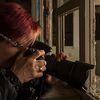Fresh green trees at Loch Katrine
09/22/2022
The sun gradually came out and it got a little warmer. The backlight, which found its way down between the mountains towards the lake, made the green leaves of the trees shine. a beautiful sight. The three-quarters of an hour flew by and we would have liked to have stayed on Loch Katrine for longer to explore the other side of the lake, which Fontane talks about in his travel report. Apart from us, there was only one other couple on board as passengers, as well as the captain and another sailor. Almost a private tour. On the way back, we decided not to go straight back to Dunkeld, but to explore the area a bit. This turned into a detour of almost three hours. Instead of taking the A821 straight towards Brick o' Turk and Callander, we chose the Duke's Pass at the junction along Loch Achray. So we drove through the small town of Aberfoyle, past Lake Menteith towards Doune and Dunblane; from where we reached Perth via the A9. In the evening I visited the Perth Arms Hotel pub in Dunkeld and ordered a pint of Best at the bar. At the next table there were three men standing in front of a variety of beers and suddenly I was given one for free. Later I returned the favour with a Lagavulin and treated myself to one too. When I arrived at Joanne and Gordon's, who had been asleep for a long time, I was overwhelmed by the absolutely fascinating starry sky in the bitterly cold late September night. I sat in the garden for a long time and craned my neck. I just couldn't get enough of it. It had been decades since I had been blessed with such a sight!
A few more facts about Loch Katrine:
"Loch Katrine (Scottish Gaelic Loch Ceiterein) is a dammed freshwater lake in Scotland. It is located in the Trossachs, belongs to the Stirling council area and has the typical elongated shape of a lake formed by glaciers during the Ice Age. Loch Katrine is about 13 kilometers long, but on average only one kilometer wide. Loch Katrine is the primary water reservoir for the greater Glasgow area. Petrol or diesel-powered ships are not allowed on the lake to avoid contamination of Glasgow's drinking water. The ship SS Sir Walter Scott has been offering tourist trips across the lake since 1899. It is powered by a triple expansion steam engine and was coal-fired until October 28, 2007. During the 2007/2008 winter break, the ship was converted to biodiesel and resumed operations in May 2008."
"In 1855, construction began on an aqueduct between Loch Katrine and the city to supply water to the growing city of Glasgow. Queen Victoria officially opened the structure on October 14, 1859. The water is drained off via an elaborately designed outlet on the south bank, which is now a Category A listed building. As a result of the increased demand for water, the system was expanded in 1885. The aqueduct to Glasgow, 38 km away, runs largely underground. Rivers and gorges are crossed on various bridges. These include the three Couligartan Aqueducts, the Duchray Bridge, and the Castle Burn Aqueduct, each of which is classified as a monument in the highest Category A."
22.09.2022
Allmählich kam die Sonne heraus und es wurde etwas wärmer. Das Gegenlicht, das zwischen den Bergen seine Weg hinunter Richtung See fand, ließ die grünen Blätter der Bäume aufleuchten. Ein schöner Anblick. Die dreiviertel Stunde verging wie im Flug und wir wären gerne noch länger auf Loch Katrine unterwegs gewesen, um auch die andere Seite des Sees zu erkunden, von der Fontane in seinem Reisebericht erzählt. Außer uns war nur ein weiteres Pärchen als Fahrgäste an Bord, sowie der Kapitän und ein weiterer Seemann. Fast schon eine private Tour. Auf der Rückreise entschieden wir, nicht auf direktem Weg nach Dunkeld zurückzufahren, sondern etwas die Gegend zu erkunden. Daraus wurde ein fast dreistündiger Umweg. Statt der A821 geradeaus, Richtung Brick o' Turk und Callander zu nehmen, wählten wir an der Abzweigung den Duke's Pass entlang Loch Achray. So fuhren wir durch das kleine Städtchen Aberfoyle, am Lake of Menteith vorbei, Richtung Doune und Dunblane; von wo wir über die A9 Perth erreichten. Abends besuchte ich in Dunkeld noch den Pub des Perth Arms Hotel und bestellte mir am Tresen ein Pint Belhavens Best. Am Nebentisch standen drei Männer vor einer Vielzahl von Bieren und plötzlich bekam ich eines davon geschenkt. Später revanchierte ich mich mit einem Lagavulin und genehmigte mir selbst ebenfalls einen. Wieder bei Joanne und Gordon, die schon lange schliefen, angekommen, überwältigte mich der absolut faszinierende Sternenhimmel, in der klirrend kalten Nacht des Spätseptembers. Ich saß lange im Garten und verenkte mir den Hals. Ich konnte mich überhaupt nicht daran sattsehen. Es war bereits Jahrzehnte her, dass mir ein solcher Anblick vergönnt war!
Perth Arms hotel pub: https://www.useyourlocal.com/pubs/perth-arms-hotel-dunkeld-85977/
Noch ein paar Fakten zu Loch Katrine:
"Loch Katrine (schottisch-gälisch Loch Ceiterein) ist ein aufgestauter Süßwassersee in Schottland. Er liegt in den Trossachs, gehört zur Council Area Stirling und hat die typisch langgezogene Form eines während der Eiszeit durch Gletscher entstandenen Sees. Loch Katrine ist etwa 13 Kilometer lang, aber im Mittel nur einen Kilometer breit. Loch Katrine ist das primäre Wasserreservoir des Großraums Glasgow. Benzin- bzw. dieselbetriebene Schiffe sind auf dem Gewässer nicht erlaubt, um eine Verschmutzung des Trinkwassers Glasgows zu vermeiden. Das Schiff SS Sir Walter Scott bietet seit 1899 Touristen-Ausflüge über den See an. Es wird mit einer 3-fach-Expansionsdampfmaschine angetrieben und wurde bis zum 28. Oktober 2007 mit Kohle befeuert. Während der Winterpause 2007/2008 wurde das Schiff auf Biodiesel umgerüstet und nahm im Mai 2008 den Betrieb wieder auf."
"Zur Wasserversorgung der wachsenden Stadt Glasgow wurde im Jahre 1855 mit dem Bau einer Wasserleitung zwischen Loch Katrine und der Stadt begonnen. Königin Viktoria eröffnete das Bauwerk am 14. Oktober 1859 feierlich. Über einen aufwändig gestalteten und heute als Kategorie-A-Bauwerk denkmalgeschützten Auslass am Südufer wird das Wasser abgeleitet. Infolge des gestiegenen Wasserbedarfs wurde das System 1885 erweitert. Die Wasserleitung ins 38 km entfernte Glasgow verläuft zu großen Teilen unterirdisch. Flüsse und Schluchten werden auf verschiedenen Brücken gequert. Hierzu zählen die drei Couligartan-Aquädukte, die Duchray Bridge, sowie der Castle Burn Aqueduct, die jeweils als Denkmäler der höchsten Denkmalkategorie A klassifiziert sind."
Quelle: https://de.m.wikipedia.org/wiki/Loch_Katrine

Loch Katrine Boottour (Panorama)
Manuel Gloger

Loch Katrine Boottour 1
Manuel Gloger













Lady Durchblick Il y a 16 heures
sehr schöne Collage....LG Ingrid
Joachim Irelandeddie Il y a 19 heures
Hier hast du wieder eine sehr schöne collage von eurer Bootsfahrt auf dem Loch Katrine gemacht Manuel!LG eddie
Vitória Castelo Santos Il y a 20 heures
Eine sehr schöne Collage.LG Vitoria
LichtSchattenSucher Il y a 20 heures
Sehr schöne leuchtend grüne Blätter am Ufer des Loch Katrine!Gruss
Roland